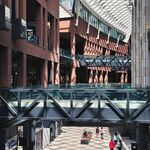In the absence of some significant geographical feature that limits it isn't any city going to sprawl, no matter how dense and urban its pre-automobile urban core might be? ... and providing it is experiencing growth and prosperity of course. Manhattan could only grow so wide because of the rivers that surround it and the huge park within it, for example. It had nowhere to go but up. Yes, Toronto's suburbs may sprawl like L.A's but is the urban core of Toronto like that of L.A'? Does L.A. have the breadth and depth of diverse, inner-city 'liveable' and affordable (relatively speaking) urban neighbourhoods that Toronto does? I don't know the answer to that because I've never been, but I would say that this is one of the more notable and outstanding features of Toronto as a city... for large chunks of it at least.
Toronto doesn't really fit any molds of other cities, rather I think it has created its own. While the downtown skyline may not be that unique (and aside from the CN Tower, really that memorable), the fact that Toronto and the GTA have multiple different 'downtowns' that could pass for skylines of any mid-size city in North America, I think really makes it unique. As was mentioned before, with most NA cities with a pretty much unlimited supply of land, you have the downtown core, and then low density suburbs.
Toronto is breaking that mold, and will continue to break that mold. The amount of densification taking place in the inner suburbs is astounding. I don't think there's another city in NA that's experienced this degree of densification outside of their urban core.
Oh, and I think the fact that Toronto has as many murders in a year as LA does in a week or two helps contribute to the liveable factor (literally).


















